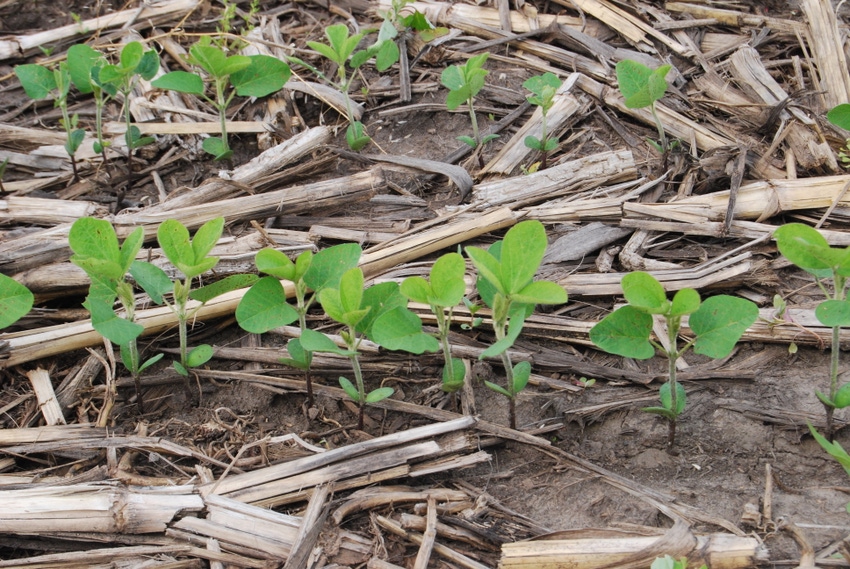
Rain was forecast for the night of June 12, for the northern half of Iowa. Those showers were definitely needed. USDA’s weekly statewide survey as of June 11 showed 40% of the state’s topsoil rated “short or very short” of moisture.
The dry weather last week allowed farmers to finish planting, make hay, spray for weeds and sidedress fertilizer. “Most of the state could use a good soaking rain, as the high temperatures and windy conditions really dried things out. Some crops are starting to show some stress as a result,” commented Bill Northey, Iowa ag secretary, when the survey report was released June 12.
The weekly weather and crop condition report said Iowa saw no widespread rain showers last week, although some parts of Iowa did get isolated thunderstorms.
Iowa corn crop rated 77% good to excellent
The survey showed 96% of Iowa’s corn acres had emerged, with 77% of the crop rated in good to excellent condition as of June 11. Farmers had 98% of Iowa’s 2017 soybean crop planted as of last week, with plants emerged or emerging on 85% of the bean acres. Condition of the soybean crop was rated 73% good to excellent.
The complete weekly crop and weather report is available at the Iowa Department of Agriculture and Land Stewardship or at USDA. The report summary follows.
Summary of weekly Iowa crop report
Dry and hot conditions helped crop development and fieldwork progress during the week ending June 11, according to USDA’s National Ag Statistics Service. Statewide there were 6.8 days suitable for fieldwork, the highest number of days suitable so far this year. However, Iowa could use rain in the next week, as some crops are showing signs of stress due to the dry conditions. Activities last week in Iowa included cutting and baling hay, spraying herbicides and sidedressing corn with nitrogen, and planting and replanting.
Topsoil moisture levels rated 7% very short, 33% short, 59% adequate and 1% surplus as of June 11. Southeast Iowa reported the lowest levels of topsoil moisture with 56% rated short to very short. Subsoil moisture rated 2% very short, 16% short, 79% adequate and 3% surplus.
Soybean planting reached 98% complete
Last week’s survey showed 96% of Iowa’s 2017 corn crop has emerged, one week behind last year. The survey showed 77% of the state’s corn crop was rated in good to excellent condition. Soybean planting reached 98% complete, over two weeks ahead of the five-year average. Soybean emergence reached 85%, two days behind last year but four days ahead of average. Soybean condition statewide is rated 73% good to excellent. Oats headed reached 44%, five days behind last year and two days behind average. Oat condition is rated 77% good to excellent.
A full week of dry weather allowed Iowa farmers to complete nearly one-third of Iowa’s first cutting of alfalfa during the week to reach 86% complete as of June 11. Hay condition decreased slightly to 83% good to excellent. Pasture condition decreased to 71% good to excellent. There were scattered reports of stress on livestock due to heat.
Weather summary for Iowa
“Last week was a very warm and dry week across Iowa,” noted Harry Hillaker, state climatologist for IDALS. “Once again, as in the previous week, there were no widespread rain events during the week ending June 11. There were a few isolated thunderstorms across the southern one-quarter of Iowa on June 4 and the northern one-quarter on June 7. The most rain came on June 8 when thunderstorms were scattered across the northeast half of the state. Finally, there were a few isolated storms over the northeast one-third of Iowa on June 9.”
Rock Valley in Iowa’s far northwest corner reported the most rain in the state for the week with 1.31 inches, most of which came on June 8. No measurable rain fell over most of Iowa. Statewide average rainfall last week was 0.04 inch, while normal for the week is 1.19 inches. The statewide average precipitation for the past two weeks (0.09 inch) is the lowest two-week total recorded during the growing season since 2002 (Aug. 25 to Sept. 8).
Unseasonably hot weather for early June
The crop reporting week began June 5 and ended June 11 with unseasonably hot weather. Humidity was quite low through the morning of June 8, with a large diurnal fluctuation in daily temperatures from cool nights to much warmer days. Humidity increased beginning on June 8 and stayed high for the remainder of the week, keeping overnight lows in the 70s June 9-10.
Daytime highs reached into the 90s somewhere in Iowa every day except June 6, while nighttime lows fell into the 40s in some locations every night from June 4 through the night of June 7. Temperature extremes for the week varied from a high of 95 degrees at Little Sioux on June 4 to a low of 44 degrees at Chariton on the morning of June 7. Temperatures for the week as a whole averaged from 2 degrees above normal in the far southeast to 10 degrees above normal in the far northwest, with a statewide average of 5.3 degrees above normal.
About the Author(s)
You May Also Like




